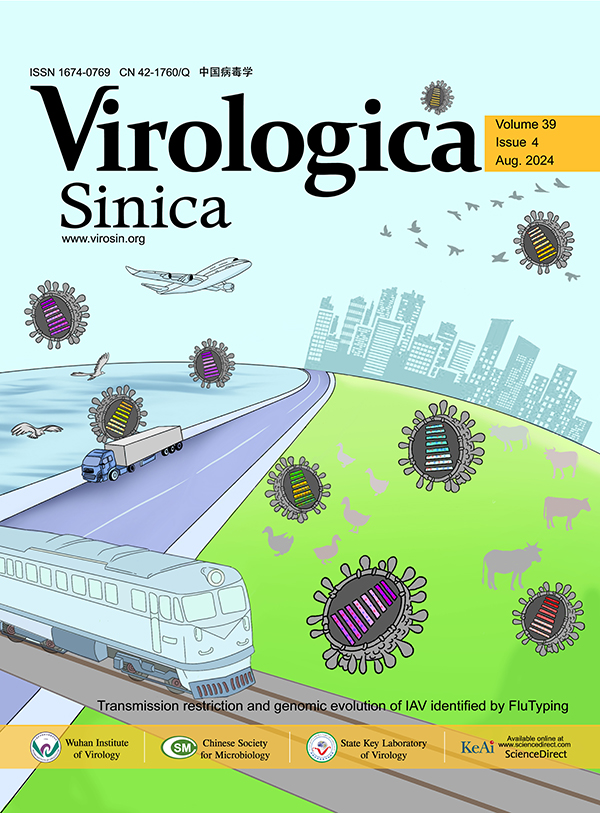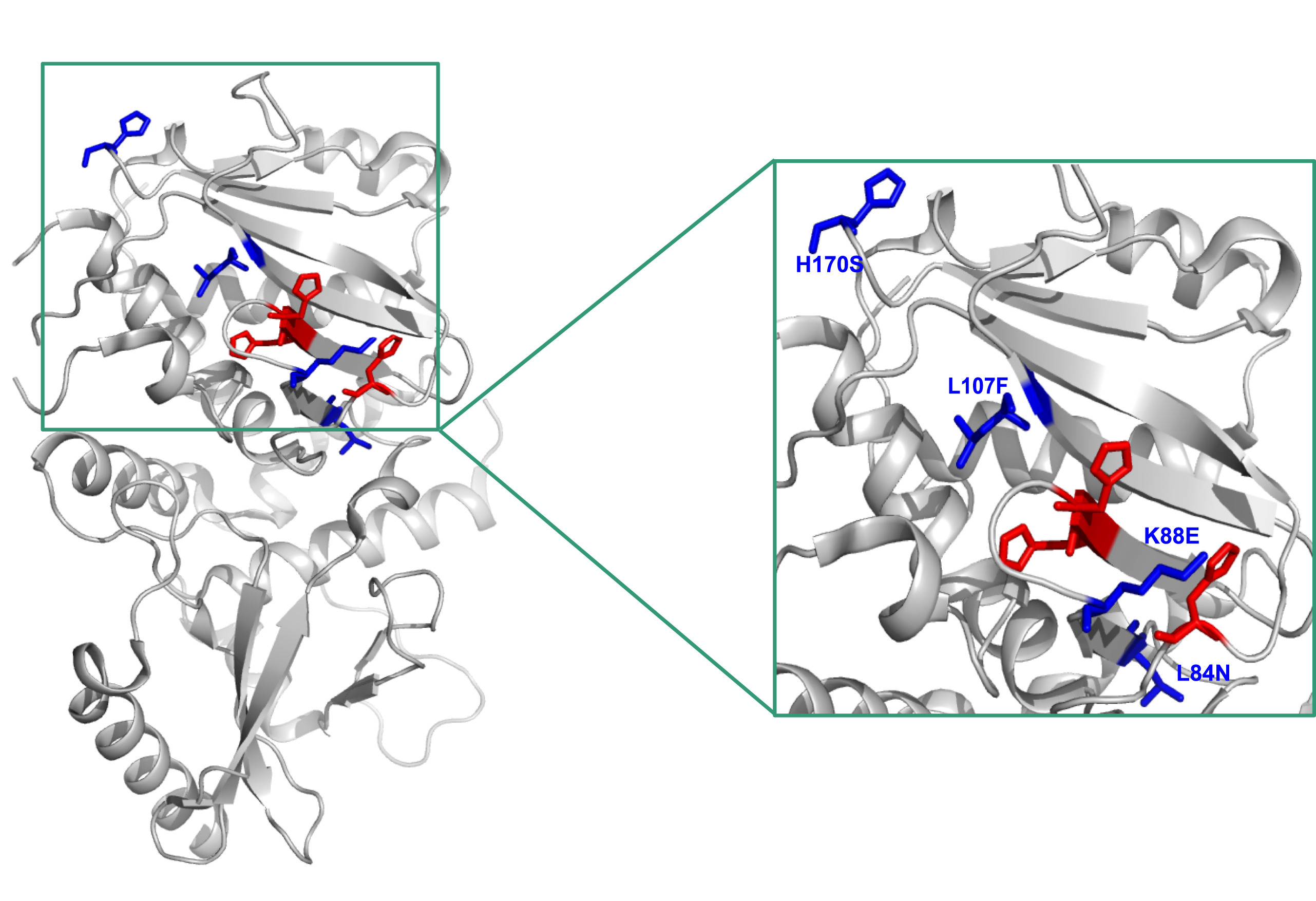-
Acciani M, Alston JT, Zhao G, Reynolds H, Ali AM, Xu B, Brindley MA. 2017. Mutational analysis of Lassa virus glycoprotein highlights regions required for alpha-dystroglycan utilization. J Virol, 91, e00574-17.
-
Cao J, Zhang G, Zhou M, Liu Y, Xiao G, Wang W. 2021. Characterizing the Lassa virus envelope glycoprotein membrane proximal external region for its role in fusogenicity. Virol Sin, 36: 273-280.
-
Carette JE, Raaben M, Wong AC, Herbert AS, Obernosterer G, Mulherkar N, Kuehne AI, Kranzusch PJ, Griffin AM, Ruthel G, Cin PD, Dye JM, Whelan SP, Chandran K, Brummelkamp TR. 2011. Ebola virus entry requires the cholesterol transporter Niemann-Pick C1. Nature, 477: 340-343.
-
Chukwudozie OS. 2020. The function annotations of ST3GAL4 in human lamp1 and lassa virus GP-C interaction from the perspective of systems virology. Access Microbiol, 2: acmi000146.
-
Cohen-Dvashi H, Kilimnik I, Diskin R. 2018. Structural basis for receptor recognition by Lujo virus. Nat Microbiol, 3: 1153-1160.
-
Cohen-Dvashi H, Cohen N, Israeli H, Diskin R. 2015. Molecular mechanism for LAMP1 recognition by Lassa virus. J Virol, 89: 7584-7592.
-
Cohen-Dvashi H, Israeli H, Shani O, Katz A, Diskin R. 2016. Role of LAMP1 binding and ph sensing by the spike complex of Lassa virus. J Virol, 90: 10329-10338.
-
Dong S, Mao W, Liu Y, Jia X, Zhang Y, Zhou M, Hou Y, Xiao G, Wang W. 2023. Deletion of the first glycosylation site promotes Lassa virus glycoprotein-mediated membrane fusion. Virol Sin, 38: 380-386.
-
Enria DA, Briggiler AM, Fernandez NJ, Levis SC, Maiztegui JI. 1984. Importance of dose of neutralising antibodies in treatment of argentine haemorrhagic fever with immune plasma. Lancet, 2: 255-256.
-
Goeijenbier M, Wagenaar J, Goris M, Martina B, Henttonen H, Vaheri A, Reusken C, Hartskeerl R, Osterhaus A, Van Gorp E. 2013. Rodent-borne hemorrhagic fevers: Under-recognized, widely spread and preventable- epidemiology, diagnostics and treatment. Crit Rev Microbiol, 39: 26-42.
-
Hulseberg CE, Feneant L, Szymanska KM, White JM. 2018. LAMP1 increases the efficiency of Lassa virus infection by promoting fusion in less acidic endosomal compartments. mBio, 9, e01818-17.
-
Israeli H, Cohen-Dvashi H, Shulman A, Shimon A, Diskin R. 2017. Mapping of the Lassa virus LAMP1 binding site reveals unique determinants not shared by other old world arenaviruses. PLoS Pathog, 13: e1006337.
-
Jae LT, Brummelkamp TR. 2015. Emerging intracellular receptors for hemorrhagic fever viruses. Trends Microbiol, 23: 392-400.
-
Jae LT, Raaben M, Herbert AS, Kuehne AI, Wirchnianski AS, Soh TK, Stubbs SH, Janssen H, Damme M, Saftig P, Whelan SP, Dye JM, Brummelkamp TR. 2014. Virus entry. Lassa virus entry requires a trigger-induced receptor switch. Science, 344: 1506-1510.
-
Kumar S, Sarkar A. 2019. Capturing the inherent structural dynamics of the HIV-1 envelope glycoprotein fusion peptide. Nat Commun, 10: 763.
-
Li S, Sun Z, Pryce R, Parsy ML, Fehling SK, Schlie K, Siebert CA, Garten W, Bowden TA, Strecker T, Huiskonen JT. 2016. Acidic pH-induced conformations and LAMP1 binding of the Lassa virus glycoprotein spike. PLoS Pathog, 12: e1005418.
-
Liu Y, Guo J, Cao J, Zhang G, Jia X, Wang P, Xiao G, Wang W. 2021. Screening of botanical drugs against Lassa virus entry. J Virol, 95, e02429-20.
-
Moraz ML, Pythoud C, Turk R, Rothenberger S, Pasquato A, Campbell KP, Kunz S. 2013. Cell entry of Lassa virus induces tyrosine phosphorylation of dystroglycan. Cell Microbiol, 15: 689-700.
-
Nunberg JH, York J. 2012. The curious case of arenavirus entry, and its inhibition. Viruses, 4: 83-101.
-
Oppliger J, Torriani G, Herrador A, Kunz S. 2016. Lassa virus cell entry via dystroglycan involves an unusual pathway of macropinocytosis. J Virol, 90: 6412-6429.
-
Raaben M, Jae LT, Herbert AS, Kuehne AI, Stubbs SH, Chou YY, Blomen VA, Kirchhausen T, Dye JM, Brummelkamp TR, Whelan SP. 2017. NRP2 and CD63 are host factors for lujo virus cell entry. Cell Host Microbe, 22: 688-696 e685.
-
Radoshitzky SR, Bao Y, Buchmeier MJ, Charrel RN, Clawson AN, Clegg CS, DeRisi JL, Emonet S, Gonzalez JP, Kuhn JH, Lukashevich IS, Peters CJ, Romanowski V, Salvato MS, Stenglein MD, de la Torre JC. 2015. Past, present, and future of arenavirus taxonomy. Arch Virol, 160: 1851-1874.
-
Sanchez A, Pifat DY, Kenyon RH, Peters CJ, McCormick JB, Kiley MP. 1989. Junin virus monoclonal antibodies: Characterization and cross-reactivity with other arenaviruses. J Gen Virol, 70: 1125-1132.
-
Shimojima M, Stroher U, Ebihara H, Feldmann H, Kawaoka Y. 2012. Identification of cell surface molecules involved in dystroglycan-independent Lassa virus cell entry. J Virol, 86: 2067-2078.
-
Thomson EC, Rosen LE, Shepherd JG, Spreafico R, da Silva Filipe A, Wojcechowskyj JA, Davis C, Piccoli L, Pascall DJ, Dillen J, Lytras S, Czudnochowski N, Shah R, Meury M, Jesudason N, De Marco A, Li K, Bassi J, O'Toole A, Pinto D, Colquhoun RM, Culap K, Jackson B, Zatta F, Rambaut A, Jaconi S, Sreenu VB, Nix J, Zhang I, Jarrett RF, Glass WG, Beltramello M, Nomikou K, Pizzuto M, Tong L, Cameroni E, Croll TI, Johnson N, Di Iulio J, Wickenhagen A, Ceschi A, Harbison AM, Mair D, Ferrari P, Smollett K, Sallusto F, Carmichael S, Garzoni C, Nichols J, Galli M, Hughes J, Riva A, Ho A, Schiuma M, Semple MG, Openshaw PJM, Fadda E, Baillie JK, Chodera JD, Rihn SJ, Lycett SJ, Virgin HW, Telenti A, Corti D, Robertson DL, Snell G. 2021. Circulating SARS-CoV-2 spike N439K variants maintain fitness while evading antibody-mediated immunity. Cell, 184: 1171-1187.e1120.
-
Wang H, Shi Y, Song J, Qi J, Lu G, Yan J, Gao GF. 2016. Ebola viral glycoprotein bound to its endosomal receptor Niemann-Pick C1. Cell, 164: 258-268.
-
Wang P, Liu Y, Zhang G, Wang S, Guo J, Cao J, Jia X, Zhang L, Xiao G, Wang W. 2018. Screening and identification of Lassa virus entry inhibitors from an FDA-approved drug library. J Virol, 92, e00954-18.
-
Wang W, Zhou Z, Zhang L, Wang S, Xiao G. 2016. Structure-function relationship of the mammarenavirus envelope glycoprotein. Virol Sin, 31: 380-394.
-
York J, Nunberg JH. 2006. Role of the stable signal peptide of Junin arenavirus envelope glycoprotein in pH-dependent membrane fusion. J Virol, 80: 7775-7780.
-
Yun NE, Walker DH. 2012. Pathogenesis of Lassa fever. Viruses, 4: 2031-2048.
-
Zhu X, Liu Y, Guo J, Cao J, Wang Z, Xiao G, Wang W. 2021. Effects of N-linked glycan on Lassa virus envelope glycoprotein cleavage, infectivity, and immune response. Virol Sin, 36: 774-783.












 DownLoad:
DownLoad: